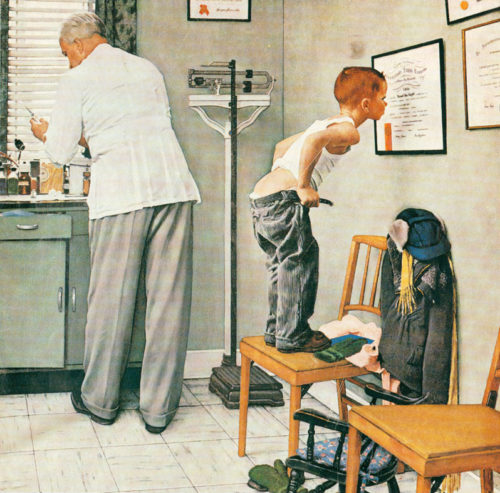Back To School Immunization Update – 2016
It seems like all I do is write “back-to-school” articles. I probably don’t but it sure seems like it.
We need, once again, to update you on back-2-school immunization strategies because – as nearly every telephone triage system in the world claims – “options have recently changed.”
Norman Rockwell painting – “Before the shot”
Children’s Immunizations: Version 20.16
I’ve written more extensively about all the immunizations previously and even given links to official CDC recommendations based on world health surveillance. In this article I’ll skip background stuff and get right to a few things parents need to be updated on – sort of a TL;DR or executive summary.
These are items from a “quick quiz” that I took on an internet medical site – and I have to say more physicians were getting wrong that were getting them right; so, we better discuss them.
2016-1017 Flu Vaccine – Northern Hemisphere
Previously I’ve given background about Influenza the disease, and Influenza the immunizations but you’ve probably still heard that there are some aspects that aren’t 100% certain. For example last year, 2015-16, the vaccine manufactured wasn’t totally specific for the Influenza “bug” that decided to make the rounds of the world.
Even so, the vaccine that was used did carry over somewhat and lessened the numbers afflicted as well as shortened the course for those who got it.
I wasn’t aware till now (although it makes sense) that vaccines made for the Northern hemisphere aren’t the same as those made for the Southern hemisphere. Our winters and summers are reversed so the virus that hammered them in our summer (their winter) is likely what will slip around to attack us this winter (their summer).
As you know there are two types of vaccine, the “trivalent” (three antigens) and the “quadravalent” (four antigens). The trivalent contains two “A” strains of influenza virus antigens and one “B” strain.
This year in our Northern Hemisphere vaccine, one of the A and the B have been changed. They now match what was given in the south last season. In addition, the quadravalent contains an additional “B” strain. Either vaccine is acceptable to the CDC, the latter is a bit more expensive.
Flu Vaccine – Nasal Spray
The US national press made a big deal about a statistical finding that the “Nasal Spray” version of the influenza vaccine didn’t work as well as the injectable.
In total, the nasal spray version only makes up about 8% of the total supply of vaccine. Unfortunately, it seems that nearly all of it was used on children because it was used on about 35% of children!
That’s why it’s been dropped in the recommendations this year. Only the injectable form should be used.
Human Papilloma Virus Vaccine

A recent addition to the childhood vaccine recommendations is HPV. Initially it was developed and given to girls because it was clear the nearly ubiquitous infection was a factor in cervical cancer.
We now know that HPV can contribute to not only cervical, vulvar and vaginal cancers but also penile, oropharyngeal, anal, and rectal cancers. It is therefore now recommended for both boys and girls; which makes sense because boys give it to girls and vice versa. And once you’ve had the disease it is apparently too late to “prevent” the predilection to the cancers it could trigger.
There are three types of vaccines available in the US (bi-, quadra- and nona-valent) covering 2, 4 and 9 of the different types of HPV viruses. Obviously, the latter is the one recommended.
Three yearly doses of the vaccine must be given, beginning at age 11 (as early as 9 if sexual abuse is known) up to age 27.
And just so you don’t mistake this for an “optional” vaccine, the CDC has statistics for almost 39,000 cases of HPV-related cancers every year in the U.S.; split about 60/40 females to males. About 80% (30,700) are actually attributed to HPV and 28,500 to those types preventable with the 9-valent HPV vaccine. Just sayin’.
Meningococcal vaccination
Meningitis I’ve written about before and even posted a YouTube video of photographer Anne Geddes’ project “protecting our tomorrows.”
About the time they are absolutely convinced they are too old to need “baby shots” (or be hugged) 11-12 year olds need a single vaccination against Meningitis “A” – and they’ll get a booster at 16.
A special shot (conjugate ACWY) is given in high-risk children as early as 6 weeks; namely, those without a spleen, those with complement component deficiencies or who are traveling to countries with endemic disease. Additionally, these children can have a Meningitis “B” vaccine and the “booster” must be of the same brand as the original shot.
Haemophilus Influenzae type b
Haemophilus Influenzae is a bacteria that causes a number of infections which, unfortunately, can look a lot like what we now call “the flu” and was initially misidentified as its cause – hence the rub.
The “flu” is caused by a virus (as described above) and Haemophilus Influenzae has nothing to do with it. We now know that there are six types of the thing (a – f) which cause everything from pink-eye and ear infections to meningitis, epiglottitis, pneumonia, arthritis, and cellulitis.
(Hib) is the name for the new vaccine they’ve developed against the most invasive and deadly of the six types. Before the vaccine, type b caused over half of the cases of meningitis every year in kids under six.
By start of school, children should have already had their course of 3 or 4 shots. The vaccine is not routinely given over 5 years of age; unless, that is, they have anatomic or functional asplenia like in sickle cell disease. Such children receive one shot.
The vaccine is also given in cancer treatment cases receiving hematopoietic stem cell transplants (HSCT) and in individuals 5-18 with HIV.

